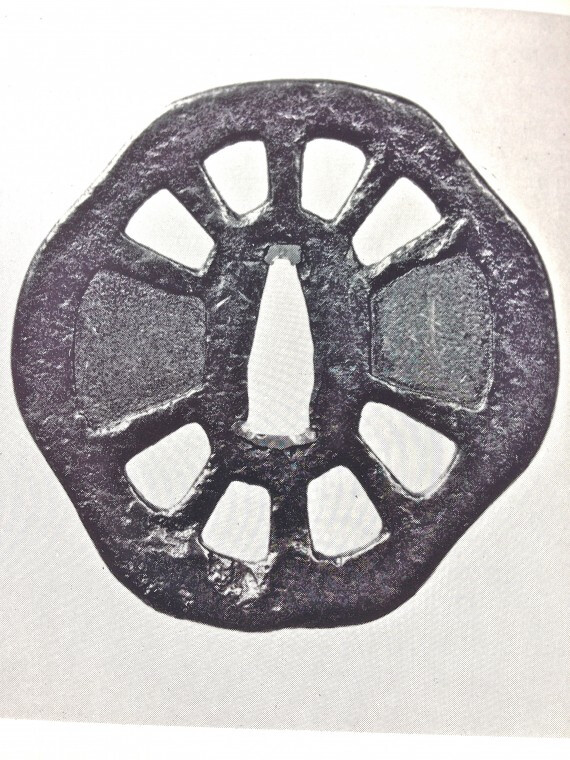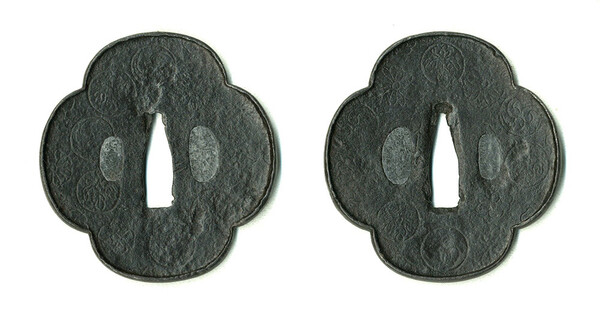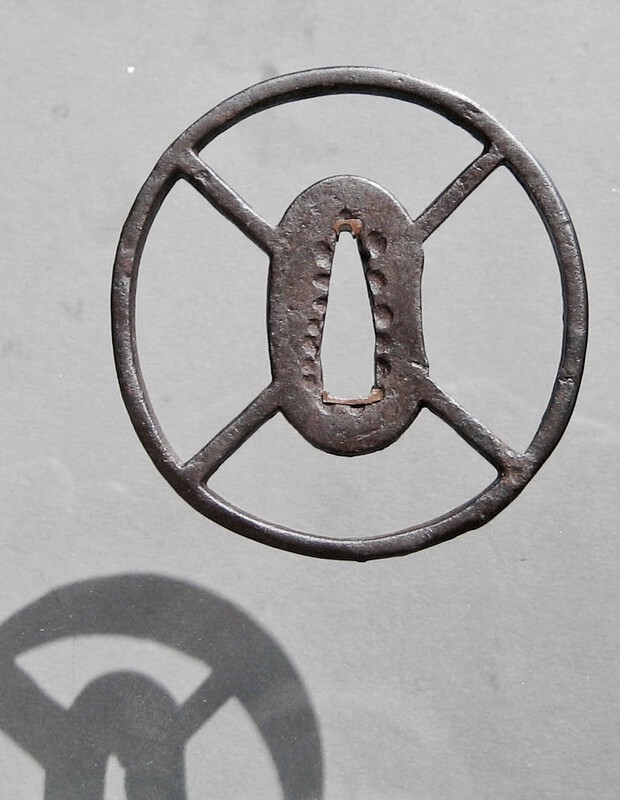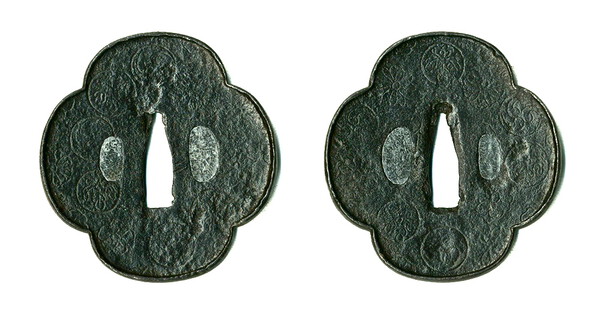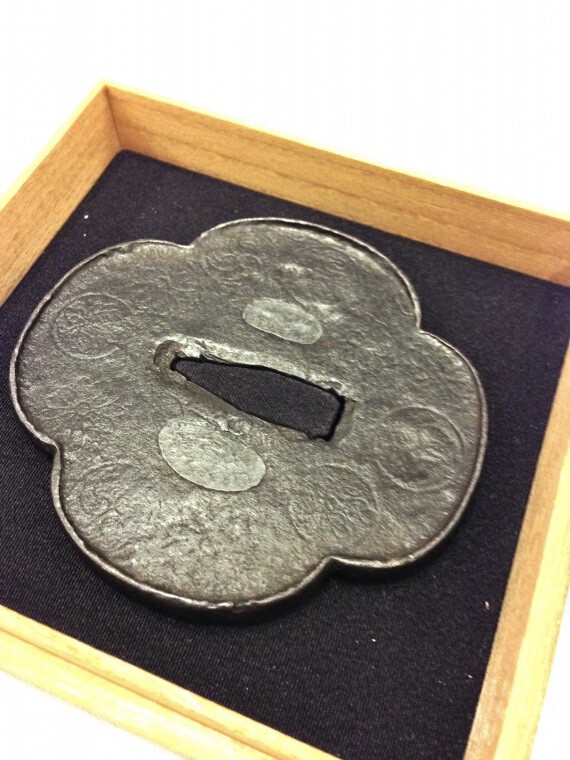-
Posts
816 -
Joined
-
Last visited
-
Days Won
3
Everything posted by Steve Waszak
-
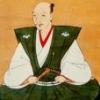
Wisdom of the crowd - which tsuba do you like the most?!
Steve Waszak replied to rkg's topic in Tosogu
Number 6, the Saotome, for sure. -

The Home of Ashiya Tea Kettles: Ashiya in Onga-gun
Steve Waszak replied to Bazza's topic in Other Japanese Arts
Thanks for posting, BaZZa. Very interesting... -

Japanese Art. What would you love to have in your Collection?
Steve Waszak replied to barnejp's topic in Other Japanese Arts
This tsuba. Yamasaka Kichibei. I've never seen another tsuba that has a greater degree of haki (vitality) than this. -
Important to recognize that for early iron, the criteria you present here, Chris --- precision of carving, quality of composition, thematic innovation --- may occupy a second tier after (or at least must make a lot of room for) such considerations as the quality of the forging, skill in hammering, deftness in use of yakite and/or tekkotsu (if present), and the patina/color of the metal. If these are weak in a given iron tsuba, the criteria you mention won't matter so much.
-
Yes, Owari. Looks like some beautiful metal, with great color. Early 17th-century would be my guess. Nice pick-up, Kyle
-
Another intriguing aspect to the design of the motif is the placement of the two types of crest: the "manji-bishi" mon are nearly all centered around the seppa-dai, while the kiri mon are placed along the perimeter of the face of the guard, essentially ringing the manji mon. I have no idea whether this arrangement would mean anything for sure, but it seems rather likely to me that some sort of semiotic impact is intended here. Others will probably have a much better idea than me...
-
Hello Jose, An intriguing tsuba. I appreciate your approach and reasoning to try to pin down the time this guard may date to, but I wonder if it is based on a small error. The Toyotomi paulownia crest (kiri mon) presents with a more complex grouping of blossoms than the usual kiri mon does. We most often see a paulownia crest depicted with three groupings of blossoms -- a group of three, a group of five in the center, and another group of three. This is how the kiri crest on your tsuba is rendered. But the Toyotomi kiri mon presents with a group of five blossoms, then a group of seven blossoms in the center, and then another group of five. The extra set of blossoms may be meant to suggest the resplendent magnificence of Hideyoshi. So, if you are correct that there would have been much sensitivity in the period to how crests were depicted/presented as well as who was allowed to use crests and in what manner, I question whether your tsuba would have direct association with the Toyotomi. However, the combination of crests we see on your tsuba is certainly interesting, and it does seem plausible that it points to clan connections/political associations of some sort. It may even be the case, as you suggest, that the kiri mon here does point to Toyotomi, despite the "lesser" rendering of the blossoms in the crest. In any event, I believe your placing of the tsuba in the later Momoyama Period is a good one. The "scattered" presentation of the crests on the plate points to a Momoyama sensibility. I have seen other Momoyama tsuba which feature crests in such a manner. I've attached an image (third photo) of a tsuba that is supposed to have been used by Oda Nobunaga. The motif is the Eiraku Tsuho coin famously associated with Nobunaga. The way the coins are "randomly" placed on the surface reminds me a bit of the placement of the crests on your tsuba. Also attached are a few images of a Nobuie tsuba from the Momoyama Period. The motif here is also crests, including a kiri mon at the top on the omote, flanked on either side by chrysanthemum crests (kiku mon). As the kiri mon is connected to the Toyotomi, the kiku mon is the crest of the imperial family. These crests presented in this manner -- with the kiri mon at the top -- may be meant to point to Hideyoshi's de facto power in the 1590s, which is when this tsuba was made, I believe. Nobuie was an Owari tsubako working for Oda Nobunaga at first; he may have then been employed by Hideyoshi after Oda's demise. Both Nobunaga and Hideyoshi were Owari men. Cheers, Steve
-
Chris, You mention that your tsuba here has a rim that is less than 3mm thick. This detail really stood out to me. I cannot recall ever having seen a genuine early Owari sukashi or Kanayama tsuba with a rim under 4mm, and 5mm, I believe is more typical (even thicker are not uncommon). I have a Momoyama Period Owari/Kanayama whose rim is 8mm in thickness (see photos). Going through the Sasano books (which include quite a few Owari and Kanayama tsuba), I cannot find a single example with a rim as thin as that on your piece. Would anyone be able to offer an example or two of an early Owari/Kanayama sword guard whose rim is under 4mm? Cheers, Steve
-
I'd never heard this word used as a noun this way. Thanks for that. I do believe that acids for use in etching in Europe did reach Japan in the second half of the 16th century, yes (good information on Jehan le Begue!). As the Shodai Hoan is known/thought to have died in 1613, and his employing of the yakite-kusarashi treatment/effect is something he's famous for, we may surmise that he could have been introduced to European acids or acid treatments. The Japanese could have seen etched European breastplates, for instance, and inquired about how that was done. Certainly there was an enormous influx of European material and ideas in Momoyama Japan. Or as you say, perhaps the Japanese had their own methods (vinegar?). Since there is so little if any information about methods and techniques used by tsubako then, as you note, too, it's hard to do more than speculate at this point...
-
Thanks, John. I certainly wouldn't describe this as Kamakura-bori. Acid etching at work in this tsuba. Sorry, but I couldn't quite grasp what you meant be "fancies" in your post here... Cheers, Steve
-
John, Might you have an image of the ura of that tsuba? I would agree with Pete that the plate look less like Kamakura-bori than something Hoan-esque. Cheers, Steve
-

The Aesthetic Appreciation Of An Hayashi Tsuba
Steve Waszak replied to Ford Hallam's topic in Tosogu
Nicely done, Ford. Cheers, Steve -
I am so, so sorry, Jean. I have experienced this more than once. It's hard to imagine what could feel worse. My deepest condolences, Jean. Steve
-
Hi Ken, Well, a few reasons. First, it's a gorgeous place to visit, and is especially so in mid-Autumn. Next, for the five of us currently signed up to attend, it is relatively centrally/conveniently located. Bruce Kirkpatrick will be guiding the proceedings; he lives in Sedona, so that certainly contributes to the reason. He has some rather fantastic Momoyama Period ceramics that wouldn't travel very well, so it's easier for us to come to him. This affords the rest of us an opportunity to see pieces that would be hard to look at, never mind handle, anywhere else. It will be a very intensive learning environment, that's for sure. Cheers, Steve
-
This tsuba was sold in a fairly recent Yahoo Japan auction. I'm wondering if any of our members here may have had the winning bid. If so, and if he is so inclined, I'd like to discuss this tsuba. PM is fine. Cheers, Steve
- 1 reply
-
- 1
-

-

Which Of Your Tsubas Best Embodies The Wabi-Sabi Aesthetic?
Steve Waszak replied to lotus's topic in Tosogu
Well said, Tim. The tsuba below, made by Shodai Nobuiye, well illustrates the ideas you express here. The mon encircling the nakago-ana are worn and distressed to varying degrees, but as you observe, this is deliberate, with the intention being to express/evoke sabi. Far from detracting from the nobility of the object, this effect greatly enhances it (that is, if one appreciates sabi ). Were this distressed/worn effect not present, the tsuba would be seen as formal; but with this sabi enhancement, the tsuba becomes semi-formal, and thus more tightly fitted to certain Tea sensibilities. Given that the piece dates to approximately 1590, when Tea Culture among the Buke was at an apex, its being made as an object exuding sabi is in keeping with its context. -
I would like to announce that there will be an “Art of the Samurai” seminar held in Sedona, Arizona on the 17th, 18th, and 19th of November, with the 16th and 20th being travel days to and from Sedona. The seminar will be focused on the intersection of and/or “dialogue” between samurai sword guards and Tea ceramics in the Momoyama and early Edo Periods. The agenda will concentrate on the following areas: 1. The origins of sukashi tsuba 2. Anonymous masters of steel sukashi tsuba 3. The influence of Hosokawa Tadaoki (Daimyo of Higo Province) 4. A close study of the master tsubako Hirata Hikozo 5. A close study of Bizen ceramics 6. The role of Namban ceramics 7. The influence of the Tea Master, Kobori Enshu As the seminar will be fairly tightly focused on Momoyama and early-Edo aesthetics as manifested in high-level tsuba and Tea ceramics, it does assume a certain level of experience and learning in this subject matter. Expertise is not a requirement for attending; however, there will not be any time spent introducing the basics of the Japanese Sword Guard. Some familiarity with the history and culture of Momoyama and early-Edo Japan would be beneficial. Additionally, the talks comprising the seminar will often be questioning or challenging certain traditionally accepted/understood ideas pertaining to the subject area. Included here is the notion of tsuba “schools,” the reliance on papers, and “Sasano-ism” (the theories and viewpoints put forth by Sasano Masayuki). For those who are uncomfortable with the “interrogation” of these, the symposium may not be a comfortable experience, and therefore not a suitable event to attend. If, on the other hand, one is open to and eager for what such pointed inquiries may yield, the event will prove very valuable. There are currently only three openings left for this seminar. It is just two months away, and given the need to book flights and accommodations early, any who are seriously interested and ready to commit to attending should act sooner rather than later. Please contact me with any questions you may have. Cheers, Steve
-
Nice tsuba, Patrick. Well done on the acquisition and linking it to an old thread. Good information on the artist, too. Cheers, Steve
-
But of course!


